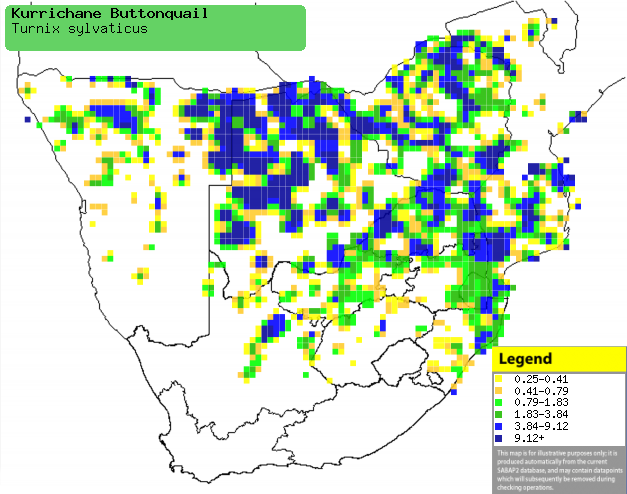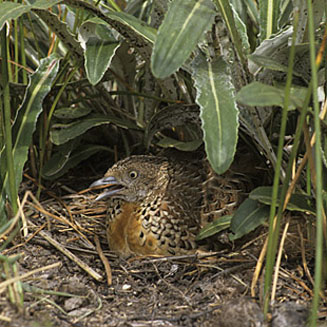|
Turnix sylvaticus (Kurrichane
buttonquail)
Bosveldkwarteltjie [Afrikaans]; Ingolwane [Xhosa]; uNgoqo
[Zulu]; Mabuaneng, Mauaneng [South Sotho]; Huta (generic name for quail) [Shona];
Xitsatsana (generic term for buttonquail) [Tsonga]; Lephurrwane [Tswana];
Gestreepte vechtkwartel [Dutch]; Turnix d'Andalousie [French]; Laufhühnchen,
Rostkehl-kampfwachtel [German]; Toirão-comum [Portuguese]
Life
> Eukaryotes >
Opisthokonta
> Metazoa (animals) >
Bilateria >
Deuterostomia > Chordata >
Craniata > Vertebrata (vertebrates) > Gnathostomata (jawed
vertebrates) > Teleostomi (teleost fish) > Osteichthyes (bony fish) > Class:
Sarcopterygii (lobe-finned
fish) > Stegocephalia (terrestrial
vertebrates) > Tetrapoda
(four-legged vertebrates) > Reptiliomorpha > Amniota >
Reptilia (reptiles) >
Romeriida > Diapsida > Archosauromorpha > Archosauria >
Dinosauria
(dinosaurs) > Saurischia > Theropoda (bipedal predatory dinosaurs) >
Coelurosauria > Maniraptora > Aves
(birds) > Order: Turniciformes > Family: Turnicidae
The Kurrichane buttonquail occurs across Africa south of
Sahel, as well is in Asia in Europe, living mainly in grasslands. It eats a
mixed diet of insects and seeds, especially of grasses. It is polyandrous,
nesting in a scrape in the ground lined with grass. It lays 2-4 eggs, incubated
solely by the male, for about 12-15 days (recorded in captivity). They chicks
leave the nest within hours of hatching, taking their first flight at about 10
days old, and are fully grown at about 35 days old.
Distribution and habitat
Widespread in sub-Saharan Africa, with relatively small
populations in Asia and Europe. In southern Africa it occurs in north-eastern South Africa, northern
Namibia, Botswana and southern Mozambique, generally preferring grassland areas as well as
mixed Mopane (Colosphermum mopane) woodland, scrub, thickets and cultivated land.
|
 |
|
Distribution of Kurrichane buttonquail in southern Africa,
based on statistical smoothing of the records from first SA Bird Atlas
Project (©
Animal Demography unit, University of
Cape Town; smoothing by Birgit Erni and Francesca Little). Colours range
from dark blue (most common) through to yellow (least common).
See here for the latest distribution
from the SABAP2. |
Predators
Food
It mainly forages in grassland, eating a mixed diet of
insects and seeds, especially of grasses.
Breeding
- It is probably polyandrous, meaning that one
female mates with multiple males, as this behaviour has been recorded repeatedly in
captivity. The complete breeding cycle takes about 53 days.
 |
|
|
Kurrichane buttonquail incubating its eggs,
Sericea farm, South Africa. [photo Warwick Tarboton ©] |
|
-
The female usually builds the nest, which is a shallow scrape in the ground
lined with grass. The site of the nest is selected by the male, usually
placed against or in between grass tufts.
-
Egg-laying season is usually in the rainy months, although it varies greatly
between different areas.
-
It lays 2-4 eggs, incubated solely by the male, for about 12-15 days
(recorded in captivity).
-
The chicks leave the nest about 4 hours after hatching, and are fed by the
male for the first 4 days of their life, after which they start to feed
themselves. They take their first flight at about 10 days old, and are fully
grown roughly 25 days later.
Threats
Not threatened.
References
-
Hockey PAR, Dean WRJ and Ryan PG (eds) 2005. Roberts
- Birds of southern Africa, VIIth ed. The Trustees of the John Voelcker
Bird Book Fund, Cape Town.
|
